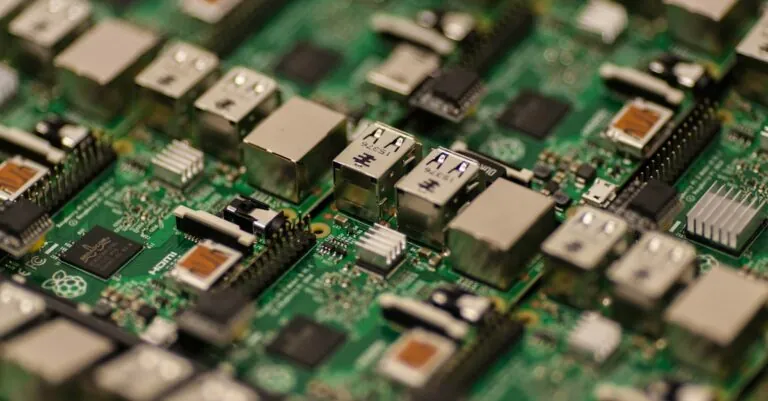Imagine a world where your coffee maker knows just how you like your brew, your fridge reminds you when you’re out of milk, and your thermostat adjusts itself while you binge-watch your favorite show. Welcome to the Internet of Things, or IoT, where everyday devices are getting smarter and more connected.
These nifty gadgets aren’t just for tech enthusiasts; they’re transforming homes and lifestyles. From smart light bulbs that can set the mood for movie night to wearable fitness trackers that keep tabs on your health, IoT devices are here to make life easier and, let’s be honest, a bit more fun. So buckle up as we dive into the fascinating world of IoT devices and discover how they’re revolutionizing the way we live, work, and play.
Table of Contents
ToggleOverview of Internet of Things Devices
Internet of Things devices encompass a wide range of technologies that connect to the internet, enabling interactions between various objects. Smart home devices like thermostats, lights, and security systems are designed for efficiency and convenience. These devices collect and exchange data, allowing users to control them remotely, improving overall energy management.
Wearable technology exemplifies another facet of IoT. Fitness trackers and smartwatches monitor health metrics such as heart rate and steps, providing users insights into their physical activity levels. The data collected can sync with apps, helping individuals achieve health goals.
In the industrial sector, IoT devices revolutionize operations through smart sensors and machinery. These devices monitor equipment performance, enabling predictive maintenance and reducing downtime. Advanced analytics allow companies to optimize production processes based on real-time data.
Healthcare benefits from IoT in numerous ways. Remote monitoring devices track patients’ vital signs, facilitating timely medical interventions. Doctors access this data through secure platforms, enhancing decision-making and patient care.
Transportation also sees significant advancements with IoT integration. Smart vehicles connect to traffic systems, optimizing routes and improving safety. Fleet management uses IoT devices to monitor vehicle location, fuel consumption, and maintenance needs.
The growth of IoT devices significantly impacts daily life and business operations. Market forecasts project that by 2030, there could be over 50 billion connected IoT devices globally. This expansion drives innovation and underscores the importance of cybersecurity measures to protect sensitive data.
Types of Internet of Things Devices
A variety of Internet of Things devices exist, enhancing everyday life and operational efficiency across sectors. These devices fall mainly into two categories: consumer IoT devices and industrial IoT devices.
Consumer IoT Devices
Consumer IoT devices simplify daily tasks and improve quality of life. Smart home appliances like security cameras and door locks allow users to monitor their homes remotely. Wearable technologies such as fitness trackers and smartwatches help individuals monitor health metrics. Home automation systems include smart thermostats and light bulbs, which optimize energy consumption. Devices like smart refrigerators provide inventory tracking, reducing food waste. Moreover, smart speakers enable voice control of various home systems. The convenience brought by these devices makes them integral to modern living.
Industrial IoT Devices
Industrial IoT devices focus on enhancing productivity and safety within various sectors. Smart sensors monitor machinery performance in real time, enabling predictive maintenance that minimizes downtime. Data analytics platforms improve supply chain management through accurate forecasting. Connected equipment tracks inventory levels, providing visibility across the production process. IoT platforms also facilitate remote monitoring of operations, reducing the need for on-site personnel. Overall, these devices drive efficiency in manufacturing, logistics, and resource management, supporting businesses in achieving operational excellence.
Benefits of Internet of Things Devices
The Internet of Things (IoT) offers numerous advantages that enhance daily life and operational efficiency across various sectors. These benefits significantly impact both consumer and industrial applications.
Enhanced Efficiency
IoT devices streamline everyday tasks by automating processes. Smart thermostats adjust temperatures based on user preferences, reducing energy waste. Connected appliances like washing machines operate during off-peak hours, saving money and energy. In industrial settings, automated machinery manages production lines more effectively, cutting down labor costs. Predictive maintenance enables machines to alert operators before malfunctions occur, preventing costly downtimes. Overall, these improvements result in more productive environments, both at home and in industry.
Improved Data Collection
Data collection becomes more accurate with IoT devices. Wearable fitness trackers transmit information on heart rate and physical activity, providing users actionable health insights. Smart home devices gather information about energy usage, allowing individuals to make informed decisions on consumption. In healthcare, remote monitoring tools track patients’ vital signs in real time, enhancing care quality. With real-time insights, businesses can analyze consumer behavior patterns, tailoring services to meet demands. Enhanced data collection leads to better decision-making and optimized strategies across all sectors.
Challenges of Internet of Things Devices
Challenges significantly impact the adoption and functionality of Internet of Things devices.
Security Concerns
Cybersecurity threats pose a major risk for IoT devices. Many devices lack robust security features, making them vulnerable to hacking and unauthorized access. Attackers can exploit these weaknesses to compromise personal data or disrupt device operations. For example, a hacked smart home security system could provide intruders access to personal spaces, raising concerns for users. Users frequently overlook the importance of updating device firmware, leaving vulnerabilities unaddressed. Ensuring end-to-end encryption adds protection against potential breaches and promotes trust in IoT technology.
Standardization Issues
Standardization matters for the interoperability of IoT devices. Without uniform protocols, devices from different manufacturers struggle to communicate effectively. This limitation hinders the full potential of IoT ecosystems and can result in a fragmented user experience. Industries often face challenges in collaborating on technology standards, leading to inconsistent device functionalities. For instance, a smart thermostat may not integrate seamlessly with smart lighting from another brand. Adopting global standards can facilitate better integration, improve user satisfaction, and foster innovation within the IoT landscape.
Future Trends in Internet of Things Devices
Emerging trends in IoT devices will shape how technology integrates into everyday life. Significant advancements are expected in smart cities, where interconnected sensors improve urban infrastructure. These systems can optimize traffic flow, reduce energy consumption, and enhance public safety, proving essential for sustainable development.
Security innovations will also become critical, as more devices connect to the internet. Enhanced encryption methods and AI-driven security protocols will help protect sensitive data from cyber threats. Many manufacturers are prioritizing robust security features, which fosters user trust and encourages widespread adoption.
Energy management will gain attention as smart energy solutions evolve. Smart meters and connected appliances will allow homeowners to monitor and control energy usage in real-time. This not only saves money but also contributes to reducing carbon footprints, aligning with global sustainability goals.
Healthcare IoT devices are set to become more sophisticated, focusing on patient monitoring and telemedicine. Wearable devices will offer advanced health analytics, enabling proactive health management tailored to individual needs. Data-driven insights will drive personalized care, improving outcomes for patients.
Blockchain technology may play a vital role in IoT device integration, enhancing data integrity and streamlining transactions in supply chains. Secure data sharing among devices will simplify processes, fostering greater efficiency across various industries.
Growth in artificial intelligence will enhance the functionality of IoT devices. AI algorithms will facilitate predictive analytics, enabling smarter decision-making in real time. Users will experience seamless interactions with connected devices, as they become more intuitive and responsive to individual preferences.
Market projections suggest that the number of IoT devices could exceed 50 billion by 2030. This growth emphasizes the importance of addressing interoperability standards among manufacturers. Establishing uniform protocols will enhance collaboration and create a cohesive IoT ecosystem.
The Internet of Things is reshaping how people interact with their environments and manage daily tasks. As smart devices become increasingly prevalent in homes and industries, they offer unprecedented convenience and efficiency.
However, addressing security and standardization challenges is essential for realizing the full potential of IoT. As technology continues to evolve, the integration of advanced security measures and interoperability standards will be vital.
Looking ahead, the future of IoT promises exciting advancements that could transform urban living, healthcare, and energy management. With these innovations on the horizon, the journey towards a more connected and efficient world is just beginning.



